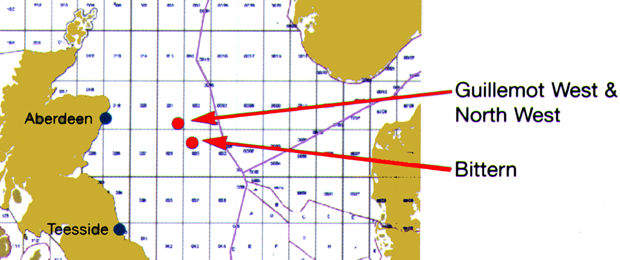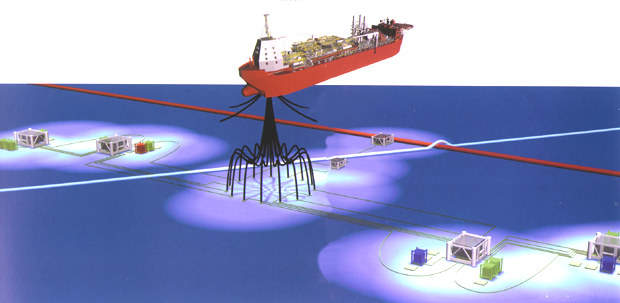The three Triton fields lie in the North Sea, 190km east of Aberdeen. They are being developed using an FPSO, located approximately 20km away from the Bittern field and 12km from the Guillemot West field, via subsea facilities comprising a series of pipelines and manifolds.
The subsea facilities comprise six subsea structures. These include four production manifolds, a subsea isolation valve (SSIV) skid and a pipeline-end manifold at the Fulmar Gas Line entry point.
This is tied back to the FPSO by a series of nine pipelines, totalling more than 160km in length.
Development
The Bittern field is being developed by a minimum of six subsea wells, four producers and two water injectors. The wells are tied into two seven-slot manifolds and tied back to the FPSO by two 10in production lines and an 8in production / test line, which is insulated to prevent wax dropout.
Guillemot West is being developed by four subsea wells, three horizontal oil producers, as well as a gas producer, which will be drilled from two sites.
The wells are into two six-slot manifolds, routed to the FPSO by two 12in production lines, which are insulated to prevent wax dropout using a pipe-in-pipe system and a 4in gas-lift line. The lines will total approximately 12km in length.
Guillemot North West is being developed by at least one horizontal oil producer using the Guillemot West infrastructure.
Production
Reservoir fluids are processed on the FPSO to enable stabilised crude oil to be exported by tanker. Gas is exported and used as fuel on the FPSO.
Production flaring should not occur during normal operations, although limited quantities of gas will be flared during the commissioning and subsequent start-up phases.
Triton FPSO
The FPSO, a double hulled tanker, will be located in block 21/30, approximately 190km (120 miles) east of Aberdeen, between the two fields. This will be located in 300ft of water.
The newbuild double-hull tanker was built in Korea and modified in the Sembawang shipyard, in Singapore. It arrived at the Tees Offshore Base, in Teesside, in December 1998. The turret, cranes and topside pallets were installed, the pallets hooked up and tested, and the facilities commissioned onshore, in mid 1999. This was prior to installation in the field.
The vessel has an overall length of 244m (800ft), a moulded breadth of 42m (138ft) and a moulded depth of 21.3m (70ft). It has a 105,000t deadweight, can store 630,000 barrels of oil (six days’ worth at peak production) and accommodates 80 people. The design life of the vessel is 20 years.
The wellstream enters the FPSO via nine flexible risers and two umbilicals, and 15 riser slots have been installed, so that additional risers can be added in the future.
Processing
The average daily production is 60,000 barrels of oil a day and 70 million cubic feet of gas a day for Bittern; 28,000 barrels a day and 50 million cubic feet a day for Guillemot West; and 4,000 barrels a day and 10 million cubic feet a day for Guillemot North-West.
The FPSO can process 105,000 barrels a day of tanker-stabilised crude oil using three stages of separation, with a dehydrator and a test separator for well testing.
Its gas system can supply 140 million cubic feet of gas a day at 173bar (2,500psi), which is dried and metered to pipeline requirements. The system consists of two 50% main gas compression trains and a 100% flash gas compressor. The gas dehydration uses a Glycol system.
The water-handling system can process 100,000 barrels of water per day (bwpd) at 30 parts per million (ppm) or less using hydrocyclones. For water injection, the FPSO can produce 125,000bwpd at 170bar (2,470psi), deaerated and filtered to 80 micron. This is pumped by one 100% pump.
Power generation is by two LM6000 dual-fuelled gas turbines (with a 42MW ISO rating). Oil will be exported by shuttle tanker and gas produced from the fields will be exported via the Fulmar Gas Line to St Fergus.
A 10in spur line, approximately 12km-long, will be used to export gas from the FPSO to the Fulmar Gas (trunk) Line.












